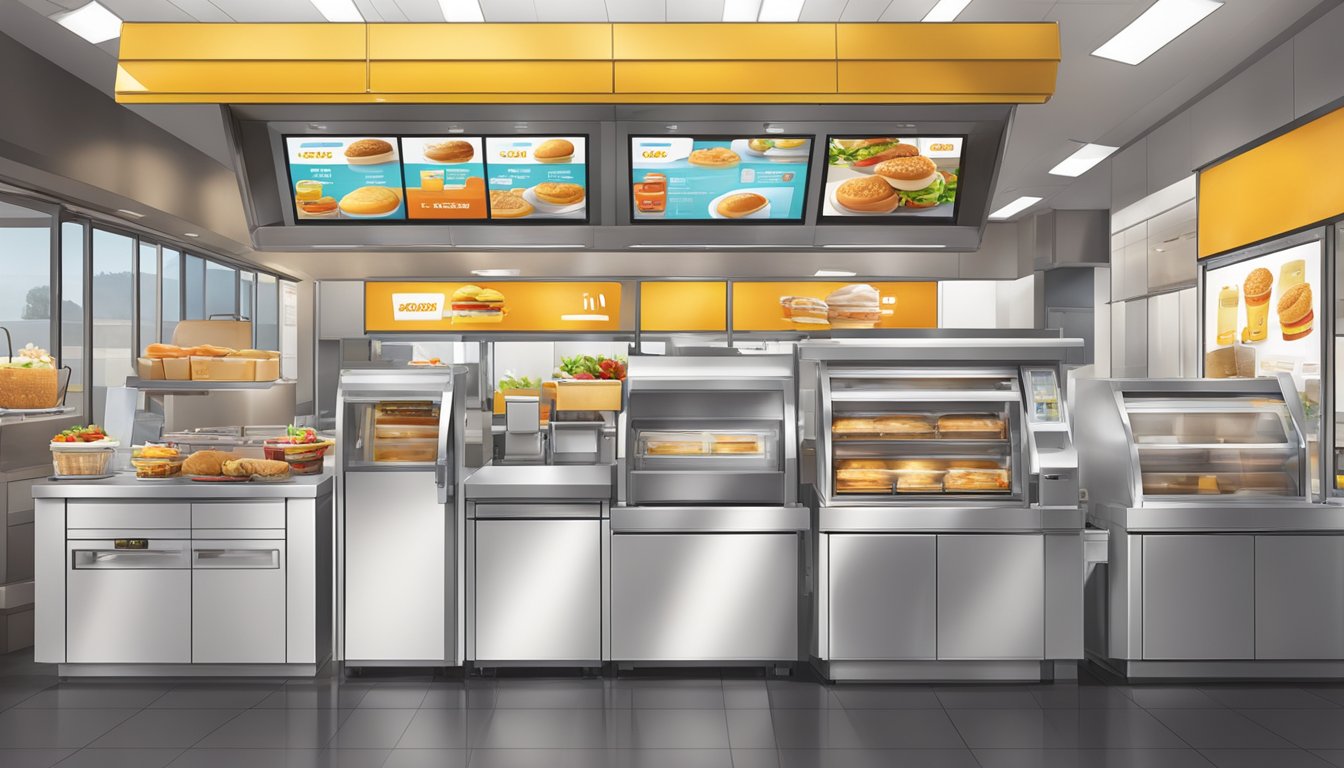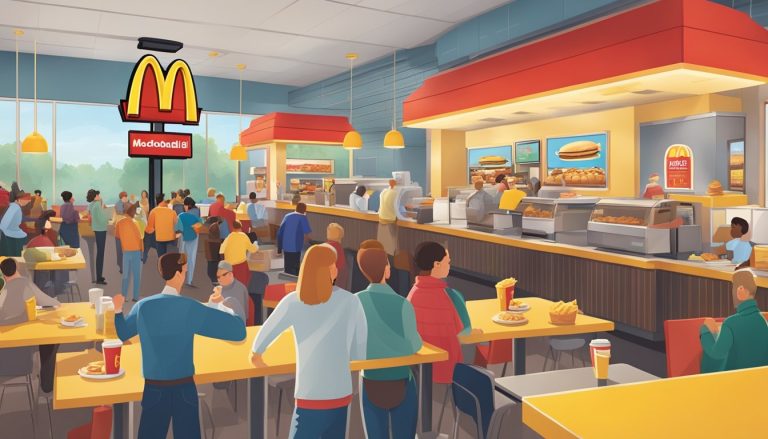McDonald’s has embraced technology to revolutionize its breakfast service, enhancing efficiency and customer satisfaction. The fast-food giant leverages digital innovations to streamline ordering processes and reduce wait times during the busy morning rush. Mobile apps, self-order kiosks, and contactless payment options have become integral parts of McDonald’s breakfast experience, allowing customers to customize their orders and skip long lines.
These technological advancements extend beyond the front-end customer interface. Behind the scenes, McDonald’s utilizes data analytics and artificial intelligence to optimize inventory management and predict customer demand for popular breakfast items. This ensures that restaurants are well-stocked and prepared to meet the morning rush with freshly prepared meals.
The integration of technology in McDonald’s breakfast service aligns with the company’s broader “Accelerating the Arches” growth strategy. By investing in digital solutions, McDonald’s aims to create a seamless and personalized experience for breakfast patrons while improving operational efficiency. These innovations have contributed to the success of McDonald’s breakfast offerings, solidifying its position as a leader in the fast-food industry.
Historical Perspective of Technology in McDonald’s Service

McDonald’s has leveraged technology to transform its breakfast service over the decades. The company’s digital evolution and technological innovations have played a crucial role in maintaining its competitive advantage in the fast food industry.
Evolution from Conventional to Digital Services
McDonald’s began its technological journey with simple cash registers and manual order-taking systems. In the 1970s, the company introduced computerized cash registers, improving order accuracy and speed. The 1980s saw the implementation of drive-thru speaker systems, enhancing customer convenience.
The 1990s brought digital menu boards, allowing for easier menu updates and promotional displays. In the early 2000s, McDonald’s started experimenting with self-service kiosks, reducing wait times and improving order customization options.
The rise of smartphones led to the development of the McDonald’s mobile app in 2015, offering digital ordering and exclusive deals. This marked a significant step in the company’s digital transformation strategy.
Milestones in McDonald’s Technological Innovation
In 2014, McDonald’s established its digital information team, focusing on innovative solutions for dining, drive-thru, and delivery services. The company introduced mobile ordering and payment in select markets in 2017, streamlining the breakfast rush.
McDonald’s acquired Dynamic Yield in 2019, implementing AI-powered menu optimization. This technology suggests menu items based on factors like weather and time of day, enhancing the breakfast ordering experience.
The company rolled out voice-activated drive-thru ordering in 2021, further speeding up service. McDonald’s also began testing automated beverage machines and robotic fryers to improve efficiency and consistency in breakfast preparation.
These technological advancements have positioned McDonald’s as a leader in quick-service restaurant innovation, particularly in its breakfast service.
Technology’s Impact on Customer Experience

McDonald’s leverages technology to enhance breakfast service, streamlining operations and improving customer satisfaction. Digital innovations have transformed how customers interact with the brand during morning hours.
Enhancing Order Accuracy and Speed
Digital menu boards and self-service kiosks boost order accuracy and reduce wait times. These systems display current menu offerings and pricing, minimizing confusion and errors. Self-order kiosks allow customers to browse options at their own pace and customize orders with precision.
Kitchen display systems relay orders directly to preparation areas, cutting down on miscommunication. Automated cooking equipment ensures consistent food quality and faster preparation times. Drive-thru lanes employ AI-powered voice recognition technology to capture orders accurately, even during busy breakfast rushes.
Personalization Through Data Analytics
McDonald’s mobile app collects customer data to offer tailored promotions and menu suggestions. The app analyzes past orders and preferences to provide personalized breakfast recommendations.
Loyalty programs track customer behavior, enabling McDonald’s to create targeted marketing campaigns. Data analytics help identify popular breakfast items and regional preferences, informing menu development and inventory management.
AI-driven algorithms predict customer demand, optimizing staffing and inventory levels during peak breakfast hours. This ensures a smoother experience for customers and reduces waste.
Convenience with Mobile Ordering and Payment
The McDonald’s mobile app allows customers to place breakfast orders in advance, reducing wait times. Users can customize their meals, save favorite orders, and reorder with ease.
Mobile payment options, including digital wallets and in-app payments, speed up transactions. This convenience is particularly valuable during rushed morning commutes.
Curbside pickup and delivery services, integrated with the mobile app, provide flexible options for breakfast on-the-go. Customers can track their orders in real-time and receive notifications when food is ready for pickup or delivery.
Digital and Mobile Platforms in Breakfast Service

McDonald’s has embraced digital technology to enhance its breakfast service. The company leverages mobile apps, personalization tools, and loyalty programs to streamline ordering and improve customer experiences.
Dynamic Yield and Personalized Offerings
McDonald’s acquisition of Dynamic Yield has revolutionized its digital menu boards. This AI-powered technology analyzes various factors like weather, time of day, and local events to suggest personalized breakfast items.
The system adapts in real-time, promoting hot coffee on cold mornings or iced options during heatwaves. It also recommends complementary items based on a customer’s current order, potentially increasing sales of breakfast combos.
Dynamic Yield’s capabilities extend to the drive-thru experience. Digital displays change based on queue length, featuring easily prepared items during rush hours to maintain efficiency.
Loyalty Programs and Value Propositions
McDonald’s loyalty program, integrated into its digital platforms, offers special incentives for breakfast patrons. Members earn points on purchases, which can be redeemed for free menu items.
The program provides targeted promotions, such as discounted breakfast sandwiches or free coffee with a meal purchase. These offers are tailored to individual preferences and ordering history.
McDonald’s uses data from the loyalty program to refine its breakfast menu and pricing strategies. This approach helps the company maintain competitiveness in the morning daypart while fostering customer retention.
Global Mobile App Integration
The McDonald’s Global Mobile App plays a crucial role in breakfast service. It allows customers to browse the menu, place orders, and pay in advance, reducing wait times during busy morning hours.
The app features a user-friendly interface with customization options for breakfast items. Customers can easily modify their orders, such as requesting egg whites or removing cheese from a sandwich.
Geolocation services within the app enable customers to find nearby restaurants and check breakfast serving times. Push notifications alert users to limited-time breakfast offers or remind them of their favorite morning meals.
Automation and Operational Efficiency

McDonald’s leverages cutting-edge technology to streamline breakfast service operations and enhance customer experiences. Automation initiatives focus on improving order accuracy, reducing wait times, and optimizing kitchen workflows.
Self-Service Kiosks and Dynamic Menu Boards
Self-service kiosks allow customers to browse menu items and place orders independently. These touchscreen interfaces offer customization options and reduce queues at traditional counters. Dynamic menu boards display real-time updates on available items and promotions.
Kiosks integrate with McDonald’s mobile app, enabling customers to access saved preferences and loyalty rewards. This seamless connectivity enhances personalization and encourages repeat visits.
Digital menu boards adapt to time of day, showcasing breakfast offerings during morning hours. They can quickly update prices and highlight limited-time specials, improving menu flexibility.
Automation in Food Preparation and Drive-Thru
Automated cooking equipment ensures consistent food quality and reduces preparation times. Smart grills adjust cooking parameters based on order volume and product type. Robotic arms assist with tasks like dispensing drinks and packaging items.
Drive-thru operations benefit from AI-powered voice recognition systems. These tools accurately capture customer orders, minimizing errors and speeding up service. License plate recognition technology identifies repeat customers, allowing for personalized greetings and order suggestions.
Automated Business Day Cutover (ABC) streamlines daily operational transitions. This system manages inventory updates, financial reporting, and shift changes, reducing manual tasks for restaurant staff.
Delivery Services Integration

McDonald’s has embraced delivery services to expand its breakfast offerings beyond the restaurant. This integration has transformed how customers access their favorite morning meals and impacted sales patterns.
Partnering with Delivery Platforms
McDonald’s collaborated with major third-party delivery platforms to bring breakfast to customers’ doorsteps. The company leveraged cloud technology to seamlessly integrate these services into its existing operations. This move allowed McDonald’s to tap into the growing demand for convenient, at-home dining experiences.
The partnership expanded rapidly, with delivery services becoming available at over 28,000 McDonald’s locations worldwide. Customers can now order their preferred breakfast items through popular apps and websites, enjoying the same quality and variety they’d expect in-store.
Impact on Breakfast Item Sales
The integration of delivery services has significantly boosted breakfast sales for McDonald’s. Morning meal options have become more accessible to a wider audience, including busy professionals and families seeking convenience.
Popular breakfast items like Egg McMuffins and hash browns have seen increased demand through delivery channels. The company’s ability to maintain food quality during transit has been crucial in driving customer satisfaction and repeat orders.
This shift has also led to the development of breakfast bundles and promotions tailored specifically for delivery customers. These offerings have helped McDonald’s capture a larger share of the growing morning delivery market.
Strategic Role of the Global Technology Department

The Global Technology Department plays a crucial role in driving McDonald’s growth and innovation. It develops technology-based solutions that support the company’s Accelerating the Arches strategy while enhancing customer and employee experiences.
Technology Strategy and Business Alignment
McDonald’s Global Technology Department focuses on aligning technological innovations with business objectives. It develops and deploys solutions that support the company’s growth strategy across its global operations.
The department works on improving digital technologies to enhance omni-channel capabilities. This includes developing mobile apps, self-service kiosks, and digital menu boards.
A key focus is leveraging edge technology and artificial intelligence to improve restaurant operations. These innovations aim to streamline processes and boost efficiency in McDonald’s locations worldwide.
Leadership by the Global Chief Information Officer
Daniel Henry, McDonald’s Global Chief Information Officer, leads the technology strategy implementation. He oversees the development of cutting-edge solutions that appear in restaurants globally.
Henry’s team is responsible for creating technology that meets evolving customer needs. This includes innovations in mobile ordering, personalized experiences, and faster service.
The CIO also manages strategic partnerships, such as the expanded collaboration with Accenture. This partnership focuses on applying generative AI solutions across McDonald’s restaurants to enhance operations and experiences.
Under Henry’s leadership, the Global Technology Department works to improve not only customer interactions but also crew and employee experiences through innovative digital solutions.
Challenges and Adapting to Change

McDonald’s breakfast service faces ongoing challenges in an ever-changing industry landscape. The company must navigate technological advancements, workforce dynamics, and regulatory requirements to maintain its competitive edge.
Adapting to Rapid Industry Shifts
McDonald’s continuously updates its breakfast service technology to meet evolving customer expectations. The company has introduced mobile ordering and self-service kiosks to streamline the ordering process.
These innovations reduce wait times and improve order accuracy during busy breakfast hours. McDonald’s also leverages data analytics to predict customer preferences and optimize menu offerings.
The integration of artificial intelligence in kitchen operations helps manage inventory and food preparation more efficiently. This adaptability allows McDonald’s to stay ahead of industry trends and maintain its position as a breakfast leader.
Employee Adaptability and Training
As new technologies are implemented, McDonald’s faces the challenge of training its workforce to effectively use these tools. The company invests in comprehensive training programs to ensure employees can operate advanced kitchen equipment and digital ordering systems.
High employee turnover rates in the fast-food industry pose an additional challenge. McDonald’s addresses this by offering career development opportunities and creating a supportive work environment.
The company also focuses on cross-training employees to handle multiple roles, increasing operational flexibility during peak breakfast hours. This approach helps maintain service quality and efficiency despite staff changes.
Compliance and Environmental Considerations
McDonald’s must navigate a complex web of food safety regulations and environmental standards. The company implements strict quality control measures and regularly updates its processes to comply with changing regulations.
Environmental impact is a growing concern in the fast-food industry. McDonald’s has taken steps to reduce its carbon footprint by implementing energy-efficient equipment in its kitchens and using eco-friendly packaging for breakfast items.
The company also works with suppliers to ensure sustainable sourcing of ingredients used in breakfast menu items. These efforts help McDonald’s maintain compliance while demonstrating corporate responsibility.
The Future of McDonald’s Digital Ecosystem

McDonald’s is harnessing cutting-edge technologies to revolutionize its digital ecosystem. The company aims to enhance customer experiences, streamline operations, and drive growth through innovative digital solutions.
Incorporating Artificial Intelligence and Big Data
McDonald’s is leveraging AI and big data to personalize customer interactions and optimize operations. AI-powered menu boards adapt to weather, time of day, and local events to suggest relevant items. Machine learning algorithms analyze vast amounts of data to predict demand, reduce waste, and improve inventory management.
The company is exploring AI-driven voice recognition for drive-thru orders, potentially reducing errors and speeding up service. Predictive analytics help McDonald’s anticipate customer preferences and tailor marketing campaigns for maximum impact.
Big data insights enable McDonald’s to refine its menu offerings and pricing strategies across different regions. This data-driven approach ensures the company stays responsive to evolving consumer tastes and market trends.
Exploring New Venues like Metaverse
McDonald’s is venturing into virtual realms to engage with younger demographics. The company has filed trademarks for virtual restaurants and goods, signaling its intent to establish a presence in the metaverse.
Virtual McDonald’s locations could offer unique experiences, such as exclusive menu items or limited-time promotions only available in digital worlds. These virtual spaces may also serve as hubs for brand-related games, social interactions, and loyalty program activities.
The metaverse initiative aligns with McDonald’s strategy to meet customers where they are, extending its reach beyond physical restaurants. This move could open new revenue streams and strengthen brand loyalty among tech-savvy consumers.
Strategic Initiatives and Accelerating the Arches
McDonald’s “Accelerating the Arches” strategy focuses on maximizing marketing, committing to the core menu, and doubling down on digital, delivery, and drive-thru. The company aims to enhance its mobile app, expanding features like mobile ordering and payment.
Investments in drive-thru technology include automated order taking and express pick-up lanes for digital orders. McDonald’s plans to increase the number of restaurants offering delivery services, partnering with various platforms to reach more customers.
The company is also exploring automation in food preparation to improve consistency and efficiency. Robotic fryers and automated drink dispensers are being tested to streamline kitchen operations and reduce labor costs.
Comparative Analysis with Competitors

McDonald’s faces stiff competition in the breakfast segment from other fast-food chains. The company’s technological innovations and digital capabilities play a crucial role in maintaining its market position and competitive edge.
Benchmarking Against Burger King and Others
McDonald’s breakfast offerings remain a key battleground against competitors like Burger King. While McDonald’s has long dominated the breakfast market, rivals have intensified their efforts to capture market share. Burger King expanded its breakfast menu with items like the Croissan’wich to compete directly with McDonald’s Egg McMuffin.
Taco Bell entered the breakfast arena in 2014, challenging McDonald’s stronghold. In response, McDonald’s introduced all-day breakfast in 2015, leveraging its operational capabilities to gain a competitive advantage. This move helped McDonald’s boost sales and foot traffic during traditionally slower periods.
Digital Capabilities and Market Performance
McDonald’s has invested heavily in digital technologies to enhance its breakfast service and overall performance. The company’s mobile app allows customers to order and pay for breakfast items in advance, reducing wait times and improving convenience. This digital integration gives McDonald’s an edge over competitors with less developed mobile platforms.
Self-service kiosks in restaurants have also improved order accuracy and speed for breakfast items. These technological advancements have contributed to McDonald’s maintaining its market leadership position. The company’s digital capabilities have helped it adapt to changing consumer preferences, such as the growing demand for contactless ordering and delivery options during peak breakfast hours.
Supply Chain and Back-End Enhancements

McDonald’s leverages advanced technologies to optimize its supply chain and back-end operations. These innovations enhance efficiency, reduce costs, and ensure consistent food quality across locations.
Supply Chain Management Innovations
McDonald’s employs sophisticated supply chain management systems to streamline operations. The company utilizes real-time tracking and analytics to monitor inventory levels and predict demand. This technology enables automated reordering of ingredients and supplies, minimizing waste and preventing stockouts.
Digital platforms connect McDonald’s with suppliers, facilitating seamless communication and order processing. These systems allow for rapid adjustments to supply quantities based on sales trends and seasonal fluctuations.
Radio-frequency identification (RFID) tags track shipments from warehouses to restaurants. This technology improves traceability and helps maintain food safety standards throughout the distribution process.
Role of Technology in Ingredient Sourcing
Advanced data analytics play a crucial role in McDonald’s ingredient sourcing strategy. The company uses artificial intelligence to analyze market trends, weather patterns, and crop yields. This information helps predict supply shortages and price fluctuations.
McDonald’s partners with tech-savvy suppliers who use precision agriculture techniques. These methods optimize crop yields and quality while reducing environmental impact. Satellite imaging and soil sensors provide valuable data to farmers, ensuring consistent ingredient quality.
Blockchain technology enhances transparency in McDonald’s supply chain. It allows the company to trace ingredients from farm to restaurant, verifying sourcing practices and food safety compliance.
Marketing and Customer Engagement

McDonald’s leverages technology to enhance its breakfast marketing and engage customers more effectively. Digital platforms and data analytics play key roles in crafting targeted campaigns and understanding consumer preferences.
Digital Marketing and Customer Touchpoints
McDonald’s employs a multi-channel digital marketing approach for its breakfast offerings. The company utilizes social media platforms to showcase new menu items and limited-time promotions. Mobile apps provide personalized offers and convenient ordering options.
McDonald’s loyalty program integrates with its digital ecosystem, rewarding customers for breakfast purchases. QR codes on packaging link to interactive content and exclusive deals. Email campaigns target specific customer segments with tailored breakfast promotions.
Digital menu boards in restaurants display dynamic content, adjusting to time of day and local preferences. These boards highlight breakfast specials and nutritional information, influencing real-time purchase decisions.
Analyzing and Responding to Customer Preferences
McDonald’s employs advanced analytics to gather insights on breakfast consumption patterns. Data from mobile app orders, in-store purchases, and customer feedback inform menu development and marketing strategies.
The company conducts regular market research to identify emerging breakfast trends. This informs the creation of new menu items and the refinement of existing offerings. A/B testing of promotional campaigns helps optimize marketing effectiveness.
McDonald’s uses predictive analytics to forecast demand for breakfast items, improving inventory management and reducing waste. Customer sentiment analysis on social media platforms guides rapid responses to feedback and helps shape future marketing campaigns.




